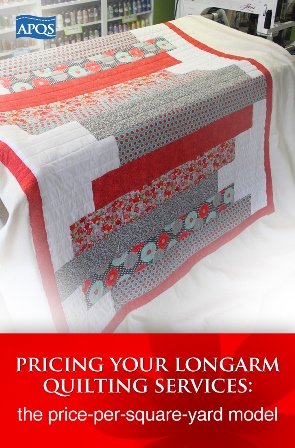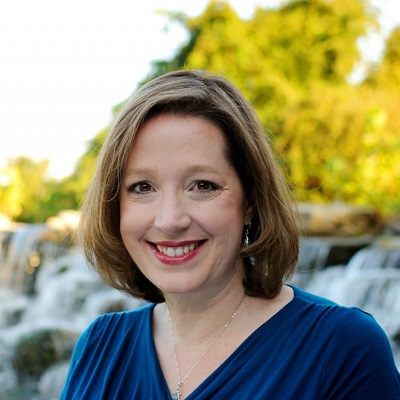Pricing your longarm quilting services using the price-per-square-yard model
If you dream in quilts, you may also have a dream of quilting for others someday while using a beautiful APQS longarm machine. But do you know what you’d charge your customers?
Setting up your studio for your quilting business can be much easier than setting up your business. There are so many decisions to make as a small business owner. A consideration must be made for both how much to charge and how to give accurate estimates to customers.
In this article we will look at how to price out your quilting service based on the total square yards found in a quilt top. Our previous article in this series focused on how to price out quilting based on the square inch.
The inherent difficulty with setting up your pricing structure is that you are forced to estimate how much time it will take you to quilt a top. If you estimate well, you earn a respectable wage. If you estimate incorrectly, you might be better off getting a job at the mall! Don’t despair, every longarm quilter has struggled to find a way to accurately estimate costs for their customer. You will learn as you go, but you’ll need to initially decide whether you are charging by the square inch, the square yard, the square foot, the overall size of the quilt top or by the hour.

Step 1: Determine your target wage
The first step to developing your own pricing structure is to determine what your personal hourly target wage is. My personal hourly target rate is around $25 hour. Sometimes I’ll make a few dollars less, sometimes I’ll make a little more. However, if I can meet that target more times than not, I’ll have a successful business and be satisfied.
Step 2: Track your time
The next step requires some diligent documentation. If you want to price your quilting accurately you need to know how much time it takes you to quilt. Keep in mind that the density and difficulty level of the quilting will influence how much time it will take to complete the quilting design. Whenever you quilt, pay attention to how much time it takes you. Don’t forget to include the time it takes to load the quilt and to set up your work space. That time you take to figure out what to quilt …you need to factor it in too!
Your smartphone has a timer on it. You likely have a timer in your kitchen too. Grab it and time yourself when you load. See how much time it takes to do one block. Grab your favorite pantograph and write down on the pattern how much time it takes you to quilt out different sizes of quilt tops. Do your homework here and it will pay off in a successful quilting business that sustains itself and doesn’t burn you out. Start documenting the size of the quilt top, the type of quilting you did and the time it took to complete it- including loading, meeting with the customer and picking out the design.
You deserve to get paid for your time so stand your ground with your customers and make sure you are getting paid for all of the time you put into a quilt. Quilting is skilled labor and we deserve to earn a wage that reflects the specialty labor our customer is requesting. If you can give the customer an accurate estimate at the beginning then both of you will be fully informed about the end price before the first stitch goes in. With good communication, you’ll have a happy customer and you won’t feel surly half way through the quilt when you realize you are making a much lower wage than you desire.
Step 3: Calculate the price per square yard
Some quilters like bill their customers by the square foot or square yard. This is very similar to pricing by the square inch but with different math.
The basic mathematical formula to determine how many square yards are in your quilt top is:
Length (in inches) x width (in inches) divided by 1296 = total square yards.
Once you know how many square yards are in the top you multiply that number by the dollars per square yard charge you’ve set.
You’ll need to have a price per square yard set for different levels of quilting. You’ll have one charge for all over, edge-to-edge quilting where the quilting design starts at one side of the quilt top and continues to the other side of the top without stopping. You’ll have a higher charge for more detailed custom quilting where different motifs are placed in blocks, borders and sashings. You’ll likely need an even higher charge for quilts that are to be judged and will be quilted heavily with lots of background fillers behind applique, stitch in the ditch and other time consuming quilting techniques.
Step 4: Do your research
At this point, many new longarm quilters ask me for examples of how much folks are charging per square yard. They want tangible examples. Well, you have a wealth of information right at your fingertips on this site! Pop over to our APQS.com forums and log in (membership is free). Now, click on the Members tab and click on “More Search Options.” In the search field labeled “URL”type in “.”(yes, that is a period). Now, click search and you’ll see all of the forum members who have listed their websites in their profiles. Click on a member and you’ll find a link to their website. Now you have a huge list of professional quilter’s websites to peruse! Most of them will have a pricing page so you can start to see what folks are charging around the country. Don’t forget to look at their additional charges too like set up fees, minimum size fees, etc.
I find that $22/square yard is fairly typical for all over, edge-to-edge quilting. Custom quilting and heirloom quilting charges vary. Some quilters will raise their custom and heirloom rates in an effort to weed out the folks looking for that type of quilting so that they only get the customers willing to pay appropriately for this highly specialized service.
The best advice I can give you is to believe in yourself. You are worth it. You deserve to be paid fairly. We quilters have big hearts and we cave on our pricing when faced with that sweet soul in the guild who is living on a fixed income when she batts her twinkly eyes. So many of us get talked into giving a discount or lowering our prices but that isn’t how a successful business is run. Stick to your decisions!
I like to think about my plumber whenever I’m faced with a business conundrum. For example, if I had two sinks clogged in my house would my plumber give me a discount on the second sink? NO! So why do I feel pressured into giving a discount on a second quilt? I shouldn’t! If my sewer backed up would my plumber give me a discount because he just got a new machine and he is still learning all the things it can do…no way! Remember… if your plumber wouldn’t do it then you shouldn’t either.
Deciding what to charge your customers can be daunting but remember that you are now a business owner and you have a responsibility to pay your employees (that’s you, sister), a living wage! If you’d like to find out more about how other quilters around the world are charging for their services, pop over to our APQS forums and linger/lurk. Do a quick search in the forums using “pricing square yard”or “pricing square feet”, you’ll find heaps of great advice from other longarm quilters about what has worked for them and where the pitfalls are.
If you’d like a sample business plan or other information about quilting for others, contact your local APQS dealer or call 800-426-7233. Finally, if you’d like to see how many customer quilts it takes to pay off one of our longarm machines, visit our website.
Angela Huffman is an APQS dealer and the owner of Quilted Joy Studio in Louisville, Kentucky



